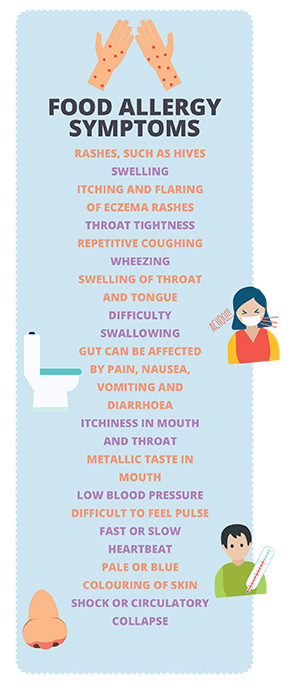About one in 20 children in Australia and New Zealand have some form of food allergy (compared to one in 100 adults), 60 per cent of which would have appeared during their first year of life. The tendency to be allergic can be familial—children who have one family member with an allergic disease (such as eczema or asthma) have a 20–40 per cent higher risk of developing an allergy of some sort.
Although some signs and symptoms of reactions can be similar, food intolerance isn’t an immune system response. People with food intolerances usually develop signs and symptoms hours after consumption, which involve the skin (such as hives, redness or swelling) and the gut.
The most common foods that cause intolerance are lactose (a sugar found in milk and most dairy products), salicylates (a natural chemical found in various fruits and vegetables), amines (a chemical produced during the formation of wine) and glutamate (an amino acid in foods containing protein).
Coeliac disease, also known as gluten intolerance, is a digestive condition that although isn’t considered an allergy, involves an immune system response: when gluten is present, the antibodies attack the lining of the small intestine, which becomes inflamed and can’t absorb nutrients and minerals from food. The only treatment is to avoid all products containing wheat, rye, spelt, kamut, triticale and barley.
A food allergy, on the other hand, happens when the body’s immune system overreacts to a particular food, believing it is harmful. As a protective mechanism, the immune system mistakenly produces antibodies called immunoglobulin E (IgE). These antibodies cause the body to produce chemicals called histamines, which can cause an allergic response. This response can range from minor skin irritations, to more serious respiratory problems, including anaphylaxis.
The most common triggers of food allergies are cow’s milk, egg, peanuts, tree nuts (such as almond and cashew), wheat, sesame, soy, fish and shellfish (such as prawn, crab, lobster). While these nine foods cause 90 per cent of food allergies in Australia and New Zealand, any food can trigger an allergic reaction.
Diagnosing a food allergy
If you think your child may have a food allergy, book an appointment with your GP or allergy specialist. If your child has displayed symptoms after consuming a particular food, avoid that food until you have seen your doctor.
To help the doctor you can prepare some documents such as:
Writing down reactions, foods consumed, amount of food, how long the reaction lasted and other relevant information.
If you have access to a camera, take photos of the symptoms.
If your child’s symptoms occurred after eating packaged food, bring a sample of it to help the specialist discover the allergy. You can also bring labels of foods you suspect could cause potential harm.
Read: How parents can boost their kid’s gut health
Diagnosis is based on your child’s history and skin prick or blood results. Nella Puz, an accredited practising dietician, says, “The common test for allergy is the skin prick test. This involves pricking the skin to place a drop of the suspected allergen. If you are allergic to the test, a small itchy lump (wheal) surrounded by a red flare will appear within 15 to 20 minutes, indicating an allergy to the substance, whether it’s food, pollen, cat dander, dust mites or bee sting.”
The size of the wheal will be measured and recorded. This test finds out the presence of IgE antibodies directed against that food, present on the mast cells of the skin. If the skin test isn’t available or the test can’t take place for other reasons, your doctor may order a blood test as an alternative.
If you have a child who currently has a food allergy, take heart that many common childhood allergies will resolve before adulthood. Most children will outgrow their allergy to cow’s milk by the age of three, and an egg allergy by six to eight years. However, children with a peanut, tree nut, shellfish, fish or sesame allergy tend to have it for life. So it’s important to have your child reassessed by your doctor regularly.
Managing and treatment your child’s food allergy
The primary way to manage a food allergy is to avoid consuming the food that causes you problems. Shopping for a child with a food allergy can be challenging, especially if your child is allergic to many foods.
Read: What do I do if my child has a food intolerance?
Labelling rules in Australia and New Zealand must display on packaging the most common allergens so carefully check ingredient labels of food products. Learn whether what you need to avoid is known by other names as other words may be used, such as casein or whey instead of milk, and make sure you read any added notes. If there is any doubt about a product’s cross-contact with an allergic food, contact the manufacturer directly.
If your child does have a minor reaction, you will need to get over-the-counter or prescribed antihistamine. Taken after coming into contact with an allergy-causing food, it can reduce symptoms and help with itching or hives.
For severe reactions, you may need an emergency injection of epinephrine and a trip to the emergency room. Many people with allergies carry an epinephrine auto-injector. This device is a combined syringe and covered needle that injects a single dose of medication when pressed against your thigh. If your child is prescribed one, make sure you and your loved ones know how to use the auto injector. Carry it with you (and the child) always, and be sure to replace epinephrine before its expiration date or it may not work properly.
By the age of 16, 80 per cent of children with a severe allergy to eggs or milk can tolerate these foods. Children with a wheat or soy allergy will often outgrow their allergy as well. Although food allergy does impact on quality of life, with education and support, it is a manageable condition.

How helpful was this article?
Click on a star to rate it!
0 / 5. 0
Be the first to rate this post!
Related posts
Subscribe
Receive personalised articles from experts and wellness inspiration weekly!

